June 10, 2014 – Today we visited La Cambe German Cemetery. Members of the SS are buried here. Entering the cemetery is actually like entering a tomb. It is sad, somber and the sacrifice of these German soldiers is not glorified. They too are invaders, buried on foreign soil. That being said, I believe that visiting these places is important to reinforce in my own mind that these young men were humans too, following orders that we would now deem to be awful and supporting an evil regime. There is much focus in the exhibition to stress the new unity between France and Germany (see European Union) instead of their bloody past and the fact that since 1870, the Germans have invaded France three times, and succeeded each time.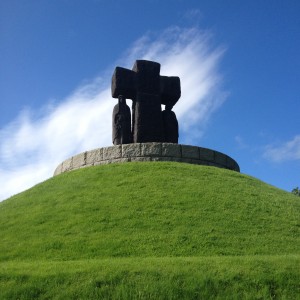
CBF Ceremonies by Jordan Fraser
June 7, 2014 – Today was the day of ceremonies for the foundation. I would like to write about the Abbaye Ardenne ceremony. This was a rather profound ceremony for me. It was by far the most intimate of the three and the most locals also came out for it. In this ceremony, the 20 Canadian soldiers from the Nova Scotia Highlanders and the Royal Winnipeg Rifles that were murdered by the Germans at the Abbaye Ardenne are remembered and commemorated. As Col. Dave Patterson read the names of the Canadians and their ages, we placed maple leafs on the monument to these murdered Canadians. I was the first student up and placed two leaves on the monument. Hearing all the names and ages, mostly in their early 20s, I cannot help reflect on what I was doing at that age and realize that these young men were doing extraordinary things in extraordinary times. This story of their capture and execution, one by one, is all the more heart-wrenching because they were shot in the back of the head and at the base of the neck. This story and ceremony reminds me also that while war is sometimes necessary, it can and does bring out barbaric sides in people and this is a telling example of that.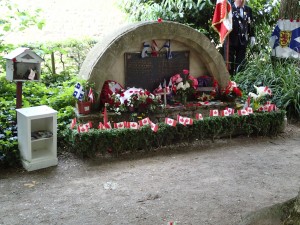
Vimy Ridge, John George Pattison and Fatherhood by Jordan Fraser
June 1, 2014 – Today we visited Vimy Ridge. What an experience! Having read and heard about this battle, it was something else altogether to see it in person. Soaring out of the ground on Hill 145 and overlooking the Douai plain, it is truly a sight. However, it is also very sobering. 10,000 Canadians fell trying to take this ridge, a cost which cannot be forgotten and is not when you visit the site. In my mind’s eye, I could see the thousands of Canadian soldiers charging through craters, barbed wire and blasted landscape to take the hill. I also had the opportunity today to visit La Chaudière Military Cemetery, where the soldier I researched is buried. Private John George Pattison, who won the Victoria Cross for his actions during the taking of Vimy Ridge on April 10th, is the soldier I researched. He died during an assault on a power plant in Lens, France on June 3, 1917. Being there and seeing his grave, it brings home the fact that he was a real person. His story for me is all the more impactful as I am on the cusp of becoming a father, and John George Pattison joined the Canadian Expeditionary Force (CEF) to protect and watch out for his son Henry. Seeing al of these maple leaf crested headstones, reading the names, inscriptions and ages, the magnitude of Canada’s sacrifice in the Great War comes into sharp relief. Confronted with the reality of the war up close and personal, I was moved to contemplate and reflect. In reflecting I realize what a different time these sacrifices were made in, as John’s wife Sophia proudly wore his Victoria Cross when she met King George VI in 1939. I did not find records of her being bitter and angry at his death, although I am sure that she mourned greatly. However, my impression is that while she mourned his death, she understood his sacrifice, something I do a little bit more after visiting his gravesite.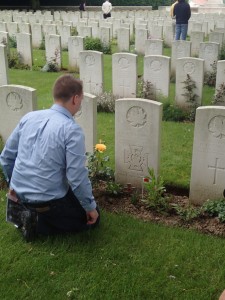

We Will Remember Them – June 3, 2014 by Allison Wiber
I have been home for just over a week now, yet the tour dominates my thoughts almost all hours of the day. I look out onto the sandy beach of my little hometown and think of our walk on Omaha. I go to make some toast for breakfast with the normal Dempster’s bread that I used to enjoy and want to cry because it’s not a fresh croissant. I lie in bed and miss having the constant comfort of my roommates. My feet are constantly moving and twitching at work because I can’t get used to sitting in a chair at a desk all day again. I miss everything about the tour – the early mornings, piling into the cars, seeing place after unbelievable place. But I miss the people most of all. The wonderful, supportive, hilarious group of people that I am more than proud to truly call my friends.
To pick just one day to talk about proved much harder than I thought it would be. When it came down to it however, I knew there was no real choice to be made; it had to be Tuesday June 3, 2014. This day made me have to face the tragic reality of all that I had been seeing.
It is one thing to learn about something in a classroom. To have a professor speak the words and you write them down furiously, trying not to miss even one. You can see the pictures and watch the documentaries and learn the facts of what occurred. You can research and hypothesize and break it down step by step. You can do all of that – quite easily if you want to. It is something completely different to be there – the feeling of standing on the ground that they stood on, touching the water and feasting your eyes on the landscape (the real landscape, not a photograph of it). I had spent my last year of my undergraduate degree at King’s University College at Western taking various Canadian History courses, one of which being a history of Canada in the Second World War. I learned about what happened at Puys on Blue Beach. I spent days reading about the horrible circumstances that the Royal Regiment of Canada found themselves in. I saw pictures of Canadian bodies lined up along the beach. All of this touched me, of course. So when it came time to pick presentation topics, the Royal Regiment at Puys was a no-brainer for me – I knew the material already, I was prepared, and I was sure that I could deliver the presentation with ease. I had no idea just how wrong I would be.
We began our day at the Villers–Bretonneux Australian National Memorial and Cemet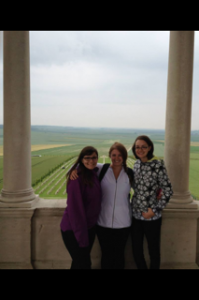 ery. It was a cool, cloudy and misty morning. It was beautiful. Not beautiful in the way that happier places are – beautiful in its solemnity. The headstones on both sides of the lawn, rather than all facing the same way, faced each other. In the centre stood a grand tower which we all climbed. The view was stunning. We took some pictures and leaned out over the ledge, taking it all in. Cemeteries are not places where I have spent much time. This trip I became well acquainted. At first I was unsure of how to react, how to be in a cemetery even. I had problems connecting where I was standing with what I should be feeling. I knew I should feel sad and emotional, and I did, but as the tour progressed I could tell the difference between being there and sad, and really being there, present and aware in the moment and immersed in the sorrow of it all. I knew I was really connected when I read someone’s name, date of death and epitaph, and it felt like gravity shifted a little. After Villers–Bretonneux we visited the Calvary Memorial for Flowerdew’s Charge. There were many informative and detailed panels to learn from. We took time to read it all and observe. It was then time to head to Dieppe.
ery. It was a cool, cloudy and misty morning. It was beautiful. Not beautiful in the way that happier places are – beautiful in its solemnity. The headstones on both sides of the lawn, rather than all facing the same way, faced each other. In the centre stood a grand tower which we all climbed. The view was stunning. We took some pictures and leaned out over the ledge, taking it all in. Cemeteries are not places where I have spent much time. This trip I became well acquainted. At first I was unsure of how to react, how to be in a cemetery even. I had problems connecting where I was standing with what I should be feeling. I knew I should feel sad and emotional, and I did, but as the tour progressed I could tell the difference between being there and sad, and really being there, present and aware in the moment and immersed in the sorrow of it all. I knew I was really connected when I read someone’s name, date of death and epitaph, and it felt like gravity shifted a little. After Villers–Bretonneux we visited the Calvary Memorial for Flowerdew’s Charge. There were many informative and detailed panels to learn from. We took time to read it all and observe. It was then time to head to Dieppe.
Typically, I spend the small amount of time right before a presentation being a completely stressed out, anxious freak. I obsess over my words and make last minute unnecessary edits and am just generally unpleasant to be around. On that day however, sitting in the back of the van with Jordan and Emilie, I was fine. Looking back that should have been my first red flag, but at the time, I just felt fine. I wasn’t even that nervous. I was just excited to share what I had learned with everybody and finally see with my own eyes what I had spent so much time studying. So as we drove steadily along the winding roads, I had an overall sense of calm and readiness.
That changed immediately as we pulled up to the beach at Puys. It was exactly how it looked in the pictures I had seen – a narrow pathway running between two soaring cliffs, a beach covered in not sand but stones. It’s not like I was surprised by what I saw. It was what I felt that was surprising. 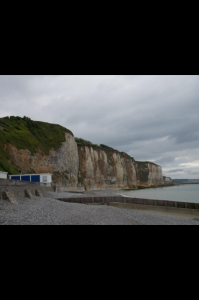 Nothing could have prepared me for the crushing emotional response to actually being there. I could barely walk over the stones to where I was supposed to present without falling. How could they have done this? I thought. This is impossible. As I waited for my turn to speak, I was looking all around. I would look at the water and think of the landing crafts and the many men who did not even make it out of them. I looked at the stones, remembering how many had been massacred right where I was standing. I looked at the cliffs, picturing enemy soldiers picking off our men in massive numbers from those perfect high ground positions. I looked at the slope upwards from the water that our men had to climb on unstable rocks. I just looked around and thought how? How could this have been thought plausible? It seemed so painfully obvious to me in that moment how dangerous and doomed the mission for Dieppe was. Before long it was my turn.
Nothing could have prepared me for the crushing emotional response to actually being there. I could barely walk over the stones to where I was supposed to present without falling. How could they have done this? I thought. This is impossible. As I waited for my turn to speak, I was looking all around. I would look at the water and think of the landing crafts and the many men who did not even make it out of them. I looked at the stones, remembering how many had been massacred right where I was standing. I looked at the cliffs, picturing enemy soldiers picking off our men in massive numbers from those perfect high ground positions. I looked at the slope upwards from the water that our men had to climb on unstable rocks. I just looked around and thought how? How could this have been thought plausible? It seemed so painfully obvious to me in that moment how dangerous and doomed the mission for Dieppe was. Before long it was my turn.
I tried not to talk too fast, but it was extremely difficult. All of a sudden every horrible fact and figu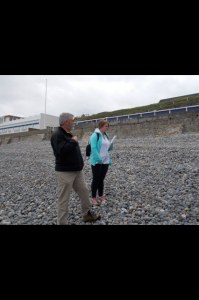 re I had written down with a heavy heart but not much problem a couple of weeks before became a struggle to get out. It was real – far more real than I could have imagined it would be. I tried my best to remain calm, only allowing pauses and breaks in my speech when emotions demanded it. I was solely focused on not crying during my presentation. It was not that I was afraid to cry in front of my tour mates, or that I think crying is embarrassing. It was that I wanted to be able to speak about the men of the Royal Regiment and tell their tragic and heroic story with as little of myself involved as possible. The last thing I wanted was to make it about me. I use the word heroic for these men because that is what they were. If you can watch your comrades, your brothers in arms, fall right in front of you and still have the courage to get off the landing craft yourself, you are a hero. I cannot fathom what it would take to make those steps and start that ascent.
re I had written down with a heavy heart but not much problem a couple of weeks before became a struggle to get out. It was real – far more real than I could have imagined it would be. I tried my best to remain calm, only allowing pauses and breaks in my speech when emotions demanded it. I was solely focused on not crying during my presentation. It was not that I was afraid to cry in front of my tour mates, or that I think crying is embarrassing. It was that I wanted to be able to speak about the men of the Royal Regiment and tell their tragic and heroic story with as little of myself involved as possible. The last thing I wanted was to make it about me. I use the word heroic for these men because that is what they were. If you can watch your comrades, your brothers in arms, fall right in front of you and still have the courage to get off the landing craft yourself, you are a hero. I cannot fathom what it would take to make those steps and start that ascent.
I finished my last line – “All that I know for sure is that I am truly honoured to stand where the men of the Royal Regiment and accompanying platoons and attachments stood” – and finally looked up at my tour mates and they clapped and smiled at me, which was very comforting. I was happy and proud that I had not broken down in the middle of my presentation like I felt I was going to. Marc asked me a question just after I was finished – “what is it like to be here and see it?” I opened my mouth, and I said a mixture of words that made no sense, ending in “uhhh” and a low groan (my widely known pre-cry tell). That was it, I was done. As my new friends scattered to explore the terrain the tears began pouring down my face. It was the first time I had really cried on the tour – the first time I allowed the emotional burden of being there take over me. Marc could see me struggling and gave me a hug – a warm, real hug that instantly made me feel a little bit better. Bobbi gave me one too – and a Kleenex of course, as she unfailingly always knew (and had) precisely what we needed. I can’t remember exactly as looking back it seems like emotional tunnel vision but I think Ryan and Amanda were there around me too – quietly telling me I did a good job and rubbing my arm. I felt so supported. We talked about how different it is to learn about something in the classroom as opposed to seeing it with your own eyes. I began to calm down. Bobbi took me along the rocks, helping me find special pieces to bring home with me and taking my picture.
It was time to head back to the cars. We walked slowly, still processing where we were. As we were waiting for everyone to return, a happy looking young man exited the washroom. We smiled and said hello. Right behind him however, coming out of the same washroom, stumbled a blushing and giggling young woman. They grabbed hands and ran away up the stairs from the beach. We all looked at each other for a moment, and then burst into laughter. We could hear them laughing too. It made me smile, and was kind of fitting. I suppose that is what we were fighting for essentially isn’t it? The freedom to fool around in a public washroom with the boy or girl you like on Blue Beach if you want to – for future generations to be that free.
After dinner that night, Marlee, Julien, Matt and I took a walk down to the English Channel – it was low tide. We walked right out into it. We couldn’t believe we were standing where we were. W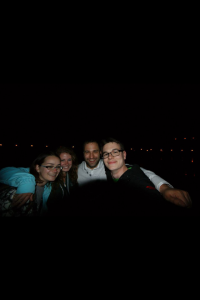 e took pictures and just stood there, staring up at Dieppe. We stayed out there for a while until we decided to walk to the pier. We walked all the way to the end of it, stopping to turn around. We could see everything. We could see where the enemy was placed, where we landed, where we fought. It was all illuminated by streetlights – we could even see the lights of Puys and Pourville. We stayed there, talking of the operation in hushed tones although we had no reason to be quiet – it just felt like we should be. We walked slowly back to the hotel, chatting pleasantly but still deep in thought. It was one of the most emotional days, but one of the best nights of the tour.
e took pictures and just stood there, staring up at Dieppe. We stayed out there for a while until we decided to walk to the pier. We walked all the way to the end of it, stopping to turn around. We could see everything. We could see where the enemy was placed, where we landed, where we fought. It was all illuminated by streetlights – we could even see the lights of Puys and Pourville. We stayed there, talking of the operation in hushed tones although we had no reason to be quiet – it just felt like we should be. We walked slowly back to the hotel, chatting pleasantly but still deep in thought. It was one of the most emotional days, but one of the best nights of the tour.
As I predicted (and hoped to be honest), the CBF Tour seems to have changed my life. I see things differently now. I have experienced things that I never thought possible. I have met people that have revealed more to me about myself than I even knew. We laughed together, we cried together, we midnight swam together. I thank each and every person who was involved with the tour, especially our fearless leaders. This tour validated for me why it is that I chose history to pursue in the first place. Because of the tour, I will be carrying on in my historical education. When Veterans Affairs came to the Moulin Morin to interview us about our experience and why we study history, they asked me a question that stuck – “do you think that every Canadian should come and see this place for themselves?” I immediately answered yes. In an ideal world, every Canadian could experience standing on the ground where our ancestors fought for freedom. Every Canadian could feel the overwhelmingly warm sentiments of gratitude that the French people extend to us. Every Canadian could visit the graves of our fallen and step foot on Juno Beach, and feel the intense and varying range of emotions that just being there brings out in you. Obviously, not every Canadian can do this – not everyone can be so lucky. But I was. My friends and I saw and felt it all, and I will bring that back to my home and community with me. I will use all that I have learned to further myself in this field. I will never forget.
